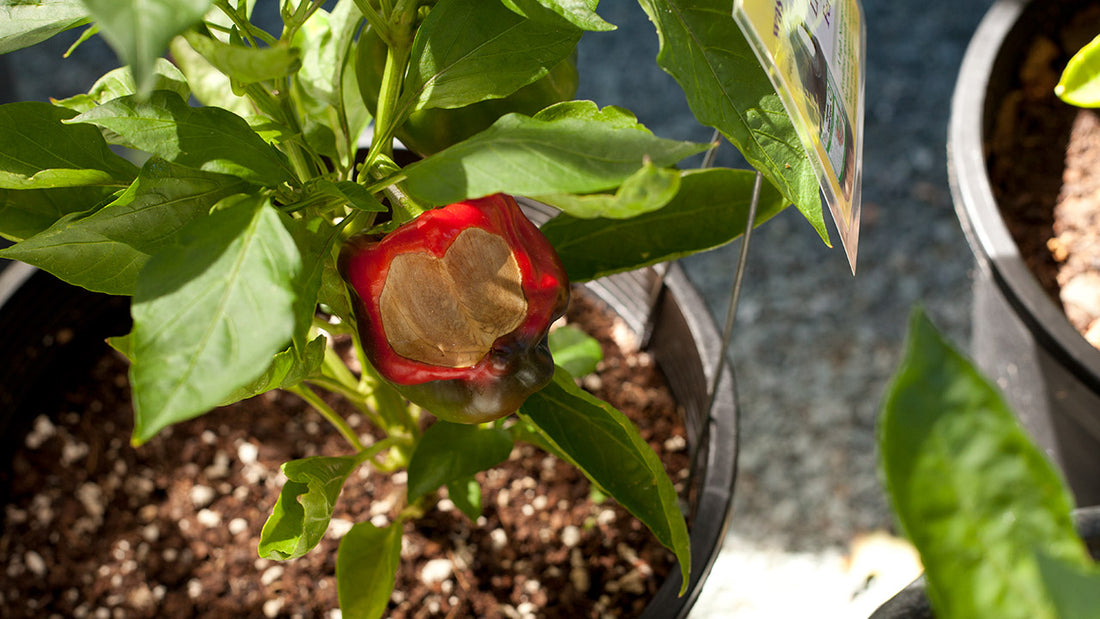Summer sun is great for our growing garden, but too much will cause damage to leaves and fruit of vegetables. Keep this from happening by installing some shade cloth over plants like peppers, lettuce or tomatoes. Tricia shows us how in the video How to Use Shade Fabric.

Why Does the Sun Cause Damage to Plants
All plants need sun to live and grow but too much, or actually too much heat can cause damage. Plant leaves and some fruit have small openings called stomata. These openings allow water loss or transpiration which in turn helps cool the plant. Leaves typically have the most stomata and cool very efficiently. Many fruits have stomata as well but some do not, such as peppers, tomatoes and apples. Thus the excess energy that accumulates during the day can lead to damage like sunburn in the fruit. Strawberries, raspberries, blackberries can also suffer from sun damage. On cane berries, the fruit will show white drupelets, which will eventually dry up. Sweet corn can show damage as well. If the temperature exceeds 95°F when the plants have silks, the silks can be damaged and dry out which will cause “zippering” or poor pollination of kernels on the ear.
Shade Cloth Application Guide
30% Shade Fabric
Good for plants that like the heat like tomatoes and peppers. In cooler climates use this also for spinach, lettuce and cold crops in the summer.
47% Shade Fabric
Good for spinach, lettuce, greens and cold crops in hot areas.
50-60% Shade Fabric
Good for shade-loving plants.
80% Shade Fabric
Use over patios, skylights to cool people as well as plants.

Shade Cloth Placement and Installation
Place the shade cloth on the west side of the plants to block the hot afternoon sun. The easiest way to install it is to erect a support structure with bamboo, wood or pvc pipe made into hoops. You can connect the cloth to the hoops with Snap Clamps or use a Clip-It that creates a grommet. You can also special order shade cloth from groworganic.com that will have grommets placed to order. With a grommet you can easily hang it over your plants or area using rope.
Knitted vs Woven Shade Cloth
Each type does an equally good job of shading your plants. One advantage of the knitted is that is does not unravel at the raw cut edge. This is a good choice if you are not having it custom hemmed and grommets added. The woven fabric is very durable but does tend to unravel at the cut end. Each type of shade cloth will do the job of protecting your plants from sun burn.


10 comments
Catherine, I would say 30% would be good for roses. This will help cool them off a bit. I think 45% might be too much, since roses like full sun.
My roses are burning up on Sacramento
What % cloth should I use?
Gayle, I would use the 30% for your blueberries and blackberries, and you may want to go with 45% for your succulents. If you want to stick to the same cloth for all, then go with the 30%.
Temps here in central California have gotten very hot like, 115. Not all the time but 110 is not uncommon. I have succulents, blackberries and blue berries. What amount of shade cloth would be good?
Cathy, well not sure how hot it gets in your area, but I think 30% would be enough to bring down some of the heat. Strawberries grow best in full sun so I would not advise using anything that cuts down the light much more. I really like the knitted 30% shade cloth, it is easy to work with, does not unwravel and is easy to install over a high tunnel. I use 30% to shade my blueberries from the hot afternoon sun in northern California.